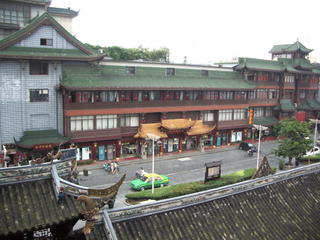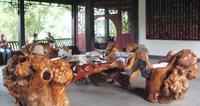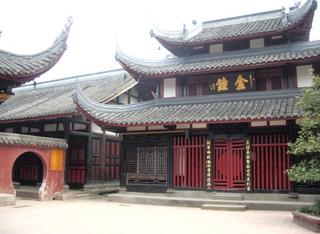Chengdu 成都 is the capital and roughly the geographic center of Sichuan 四川 province. It's easy to travel to other destinations from here. The 双流airport is less than 30Km south of city center (¥10 shuttle bus between the airport and 锦江宾馆). There're 4 major long distance bus centers on all 4 directions of the city.
 My favorite stree is Qintai Rd 琴台路: remodeled in the style of Han 汉 and Tang 唐 dynasties. It is where 卓文君 sold drinks after she eloped with 司马相如. (Click here for more about this 2000 year-old love story.) Two blocks of wide street, between 12-Bridge Rd (十二桥路) and South River (南河, or 浣花溪), stone pavement, inlaid with over 900 naturaly blue stones artistically carved with scenes of Han 汉 dynasty. Bronze statues, store fronts and even the street lamps are specially designed. Activities every night: tea ceremony, dances in costum, in order to lure the passers by. Busy, but not too noise.
My favorite stree is Qintai Rd 琴台路: remodeled in the style of Han 汉 and Tang 唐 dynasties. It is where 卓文君 sold drinks after she eloped with 司马相如. (Click here for more about this 2000 year-old love story.) Two blocks of wide street, between 12-Bridge Rd (十二桥路) and South River (南河, or 浣花溪), stone pavement, inlaid with over 900 naturaly blue stones artistically carved with scenes of Han 汉 dynasty. Bronze statues, store fronts and even the street lamps are specially designed. Activities every night: tea ceremony, dances in costum, in order to lure the passers by. Busy, but not too noise. We stayed at 文君楼 on Qintai Rd 琴台路. Very close to major attractions. In fact, we walked to 杜甫草堂. A very nice hotel, except that the water's temperature has its own mind. The best eatery in this neighborhood is the Long Wonton branch store at the 12-Bridge Rd (龙抄手十二桥路分店) next to the Chinese Medicine College (中医学院).
We stayed at 文君楼 on Qintai Rd 琴台路. Very close to major attractions. In fact, we walked to 杜甫草堂. A very nice hotel, except that the water's temperature has its own mind. The best eatery in this neighborhood is the Long Wonton branch store at the 12-Bridge Rd (龙抄手十二桥路分店) next to the Chinese Medicine College (中医学院). A block to the west is Qinyang Temple 青羊宫 (¥10), started in Tang 唐 dynasty. Legend has it that Taoism' creator 老子 left 尹喜 the Tao bible 道德经 on his way to the west, and told him to wait for him 1000 days later in Chengdu where a green sheep resides. This is said to be the location.
A block to the west is Qinyang Temple 青羊宫 (¥10), started in Tang 唐 dynasty. Legend has it that Taoism' creator 老子 left 尹喜 the Tao bible 道德经 on his way to the west, and told him to wait for him 1000 days later in Chengdu where a green sheep resides. This is said to be the location.South of 琴台路, across the river 浣花溪 is a free public park: 百花潭公园, filled with people around dinner time, drinking tea, cracking watermelon seeds and playing Marjang. There's a year-round bonsai display emphasizes the local 巴蜀 style. A jinko tree of the 唐 dynasty. There's a stone sculpture next to the bridge entrance to the park commemorates the patriotic poet Lu,You (陆游 1125--1210), with a poem of his depicting the bloom of local plum blossoms:
当年走马锦城西,曾为梅花醉似泥,二十里中香不断,青羊宫到浣花溪.
It is the wrong season now for the plum blossoms. However, I got a whiff of the sweet scent of 桂花 (Osmanthus Fragrans Lour). They have a lot of this tree, but not in bloom yet.
 West of the park, bordering the river 浣花溪 is Dufu Thatched Hut 杜甫草堂 ¥60 (students and seniors 50%, seniors over 70 free), a park built on the location of the original hut where the great poet 杜甫 (712-770AD) stayed for almost 4 years after he escaped the political turmoil (安史之乱) in late 759 from the capital. He wrote over 200 poems here, among which is 茅屋为秋风所破歌 (always included in the middle school textbook).
West of the park, bordering the river 浣花溪 is Dufu Thatched Hut 杜甫草堂 ¥60 (students and seniors 50%, seniors over 70 free), a park built on the location of the original hut where the great poet 杜甫 (712-770AD) stayed for almost 4 years after he escaped the political turmoil (安史之乱) in late 759 from the capital. He wrote over 200 poems here, among which is 茅屋为秋风所破歌 (always included in the middle school textbook). The current park has been "renovated" throughout the history and expanded to include the neighboring 梵安寺 temple to the east and plum garden 梅园 to the west. Various pavilions / sculptures were added. You can find historial editions of books on 杜甫 and his writing. Nicely laid out gardens and ponds, pleasant to stoll about (before the tourist groups arrive). In the morning, you can see local seniors do group excersize here. Fun to watch.
The current park has been "renovated" throughout the history and expanded to include the neighboring 梵安寺 temple to the east and plum garden 梅园 to the west. Various pavilions / sculptures were added. You can find historial editions of books on 杜甫 and his writing. Nicely laid out gardens and ponds, pleasant to stoll about (before the tourist groups arrive). In the morning, you can see local seniors do group excersize here. Fun to watch. One court yard was delicated to bonsai and another to wooden plaques with 杜甫's poems written by famous people.
One court yard was delicated to bonsai and another to wooden plaques with 杜甫's poems written by famous people.At the far end of this park, a new exhibition hall was openned at the begining of 2005, in order to protect and display the Tang 唐 ruin excavated here in 2001. You get a glimpse of what the local residence really looked like: quite primitive.
There's a free bus that runs between 杜甫草堂 and 武侯祠 if you buy the tickets from them. It runs on the hour between 10am-3pm.
 Wuhou Memorial 武侯祠 ¥60 (students and seniors 50%, seniors over 70 free) was originally built in the 7th centurys to honor the greatest strategist 诸葛亮 (181-234AD). Burnt during the wars, what we see now was built in the 1400s, and restored and expanded since then. The stone carvings of calligraphy surrounding the front courtyard are most interesting. Be sure to seek out 出师表 calligraphed by 陆游 near the entrance, and the Tang 唐 dynasty epitaph "蜀汉丞相诸葛武侯祠堂碑" (composed by 裴度,calligraphed by 柳公绰,and carved by 鲁建).
Wuhou Memorial 武侯祠 ¥60 (students and seniors 50%, seniors over 70 free) was originally built in the 7th centurys to honor the greatest strategist 诸葛亮 (181-234AD). Burnt during the wars, what we see now was built in the 1400s, and restored and expanded since then. The stone carvings of calligraphy surrounding the front courtyard are most interesting. Be sure to seek out 出师表 calligraphed by 陆游 near the entrance, and the Tang 唐 dynasty epitaph "蜀汉丞相诸葛武侯祠堂碑" (composed by 裴度,calligraphed by 柳公绰,and carved by 鲁建). A couple of memorial halls form a straight line, starting from the one for the king 刘备, ending with 诸葛殿, housing silly yet colorful sculptures of the appropriate personage. To the west (have to go in next to the main south entrance) is 惠陵, the tomb of 刘备. The garden here is not as interesting, but, I found some very lovely chairs.
A couple of memorial halls form a straight line, starting from the one for the king 刘备, ending with 诸葛殿, housing silly yet colorful sculptures of the appropriate personage. To the west (have to go in next to the main south entrance) is 惠陵, the tomb of 刘备. The garden here is not as interesting, but, I found some very lovely chairs. The street next to 武侯祠 on the east, Jing-Li 锦里, is renovated in Ming 明 Qing 清 style. Filled with small vendors and eateries. Much smaller in scale, compared to 琴台路. Apart from these two traditional-style streets, Chun-Xi Rd 春熙路, a wide pedestrian street, is also worth some of your time. It's at the city center, the busiest shopping district. Do stop by 龙抄手, a traditional cafeteria famous for its snacks.
The street next to 武侯祠 on the east, Jing-Li 锦里, is renovated in Ming 明 Qing 清 style. Filled with small vendors and eateries. Much smaller in scale, compared to 琴台路. Apart from these two traditional-style streets, Chun-Xi Rd 春熙路, a wide pedestrian street, is also worth some of your time. It's at the city center, the busiest shopping district. Do stop by 龙抄手, a traditional cafeteria famous for its snacks. YongLin 永陵, a small museum containing just the tomb of king 王建 (847─918年). His family only ruled for two generations. Discovered in 1942, it has stone carvings of court band (the only one of the kind of that era), with 24 musicians playing various instruments. The tomb is at least 10 degrees cooler than outside. The best part is that we were the only visitors at that time.
YongLin 永陵, a small museum containing just the tomb of king 王建 (847─918年). His family only ruled for two generations. Discovered in 1942, it has stone carvings of court band (the only one of the kind of that era), with 24 musicians playing various instruments. The tomb is at least 10 degrees cooler than outside. The best part is that we were the only visitors at that time. Wenshu Temple 文殊院 ¥20 (students 50%) is the headquarter of the provincial Buddhist Association, honoring Manjusri Bodhisattva. Started in Tang 唐 dynasty, destroyed in wars, restored by 慈笃 in 1681. Very busy here, full of chanting and incense. Not very interesting to nonbelievers like me, unless you want to try their vegetarian restaurant. I only took one picture of a building with my name on it.
Wenshu Temple 文殊院 ¥20 (students 50%) is the headquarter of the provincial Buddhist Association, honoring Manjusri Bodhisattva. Started in Tang 唐 dynasty, destroyed in wars, restored by 慈笃 in 1681. Very busy here, full of chanting and incense. Not very interesting to nonbelievers like me, unless you want to try their vegetarian restaurant. I only took one picture of a building with my name on it. To catch a long distance bus to the south, go to the main transit station (客运中心), where we went to an old town called HuangLongXi 黄龙溪镇 on our last day in SiChuan 四川. It is far less interesting than those water towns near Shanghai. The bus (¥11) is awfully slow: the driver stopped at every possible street before he filled the bus up. So 40-some Km took him 2 hours. On the way back, we took a bus to 双流 and asked to be dropped near the airport and then hailed a taxi.
To catch a long distance bus to the south, go to the main transit station (客运中心), where we went to an old town called HuangLongXi 黄龙溪镇 on our last day in SiChuan 四川. It is far less interesting than those water towns near Shanghai. The bus (¥11) is awfully slow: the driver stopped at every possible street before he filled the bus up. So 40-some Km took him 2 hours. On the way back, we took a bus to 双流 and asked to be dropped near the airport and then hailed a taxi.卓文君, a young widow of both beauty and brain in the time of 汉武帝 (~100BC), also a connaisseur of music, is from a family of status. After hearing 凤求凰, a song composed and played for her by a young admirer 司马相如, eloped with this talented commoner. Her father disinherited her. In order to make a living, they ran a small bar, 文君 sold drinks and 相如 worked in the kitchen and sometimes played music. Eventually, her father calmed down and accepted them. Later, 相如 was summoned to the capital by the emperor. After 5 years, falling for another woman, 相如 sent his wife a n empty letter with just numbers, all except the number 亿, which shares the same sound as feeling 意. 文君 wrote back the following poem using all these numbers, and her husband was so ashamed and came home to take her with to the capital.
一别之后,两地相思,说的是三四月,却谁知是五六年。七弦琴无心弹,八行书无可传,九连环从中折断。十里长亭望眼欲穿。百般怨,千般念,万般无奈把郎怨。
万语千言道不尽,百无聊赖十凭栏。重九登高看孤雁,八月中秋月圆人不圆。七月半烧香秉烛问苍天,六月伏天人人摇扇我心寒,五月榴花如火偏遇阵阵冷雨浇花端,四月枇杷黄,我欲对镜心意乱,三月桃花随流水,二月风筝线儿断。噫!郎呀郎,巴不得下一世你为女来我为男。
凤求凰
凤兮凤兮归故乡,遨游四海求其凰。有一艳女在此堂,室迩人遐毒我肠,何由交接为鸳鸯?
凤兮凤兮从凰楼,得托子尾永为妃。交情通体必和谐,中夜相从别有谁?”